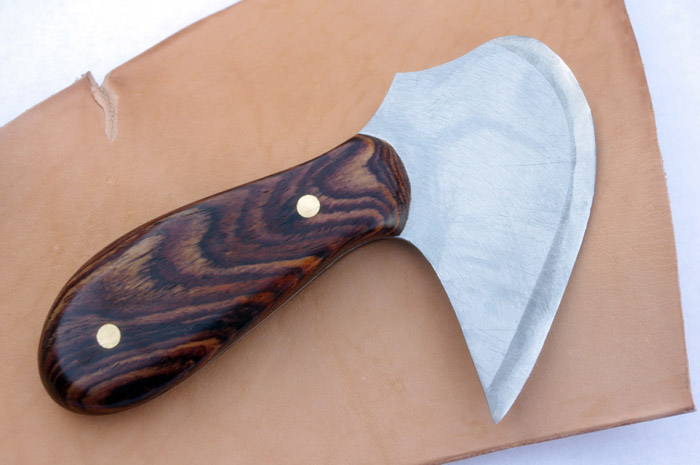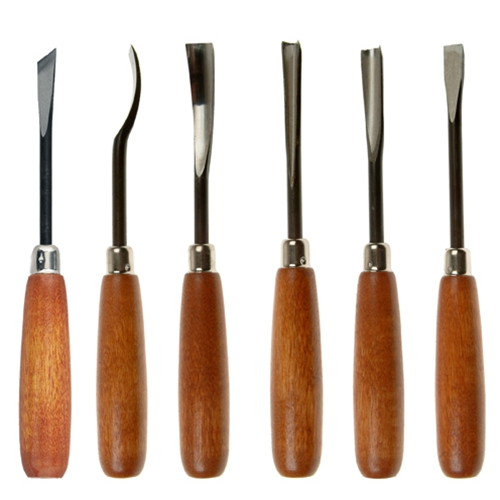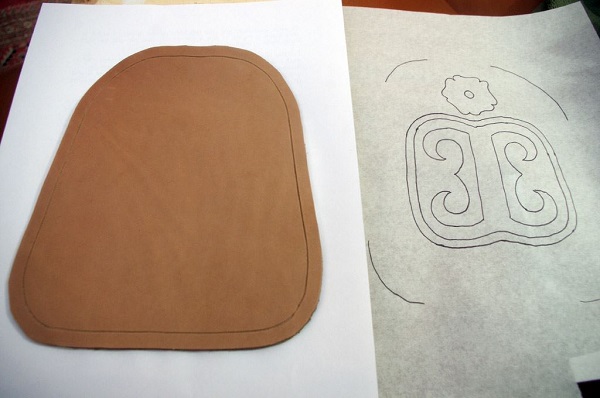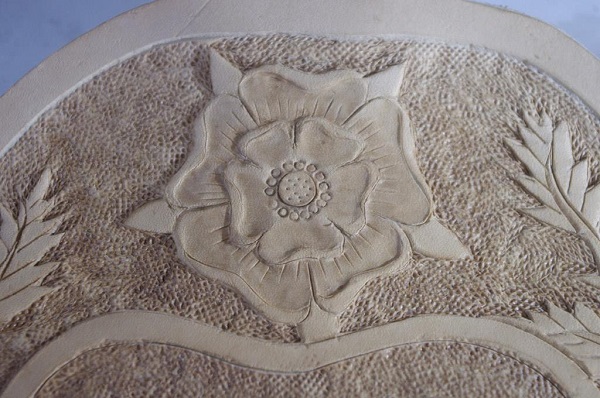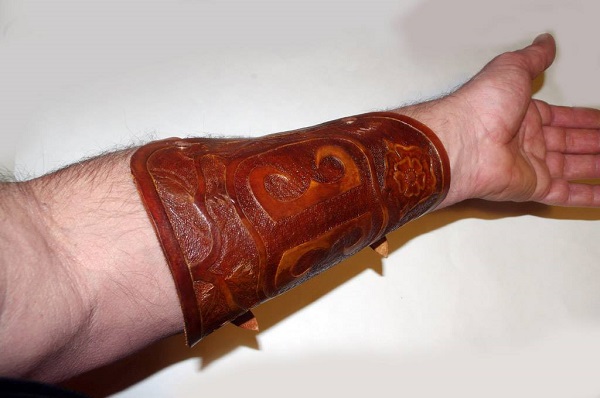
Harry Marinakis
Members-
Posts
123 -
Joined
-
Last visited
Content Type
Profiles
Forums
Events
Blogs
Gallery
Everything posted by Harry Marinakis
-
Post beginning April 27, 2017 https://www.bladesmithsforum.com/index.php?/topic/35179-two-swords-in-progress/ EDIT: on page 2
-
Never mind!! Found the answer: A "hot scribe" is a home-made leather carving knife heated with a torch. Simple to make. Same with the awl.
-
Recently I read an old tutorial by someone who does really nice, fine, detailed, and ornate leather tooling. He described using a "hot scribe" to deepen the lines that he cut with a carving knife, and "hot awl" for embossing. What exactly is a "hot scribe" and "hot awl?"
-
Looking for all-natural veg-tan leather
Harry Marinakis replied to Harry Marinakis's topic in Suppliers
I ordered a side of natural veg-tan tooling leather from Hermann Oak. At $11/square foot, it was almost $300 with shipping. I'll run some natural dye experiments with this leather, versus cheaper veg-tan tooling leathers, and post the results here. The experiment that prompted this search was dyeing with natural walnut extract. When dyeing one cheap veg-tan tooling leather with walnut, it instantly turned a beautiful, rich brown with one application of extract. Another veg-tan tooling leather didn't change color at all, even with a 24-hour soak. -
Looking for all-natural veg-tan leather
Harry Marinakis replied to Harry Marinakis's topic in Suppliers
I agree, Bill I have been experimenting with both topical dye application and soaking. Natural dyes often require 5 to 15 applications, with drying between coats. Soaking in dye for a few days is usually effective, but it requires a lot more dye, and you use up a lot more dye at a faster rate. I ran into some problems with modern veg-tan tooling leathers refusing to take any natural dye at all, even with 3-day soaks. Surprisingly, most of the ancient dye recipes from the middle ages specify topical application of the dye, not soaking! -
Looking for all-natural veg-tan leather
Harry Marinakis replied to Harry Marinakis's topic in Suppliers
I've been using Tandy leather for years. The quality of their leather is so poor that it is not usable for this particular need. -
Looking for all-natural veg-tan leather
Harry Marinakis replied to Harry Marinakis's topic in Suppliers
Thanks I'm making natural leather dyes from old manuscripts that are 700-1,000 years old. I've got about 30 colors dye colors so far. I'm running into problems of unpredictable dyeing results - some dyes will instantly dye some "veg-tan" leathers, but the same dye won't dye other "veg-tan" leather at all. I'm going to switch to all-natural leather, or at least to all-natural as I can to see if I get better results. -
Looking for all-natural veg-tan leather
Harry Marinakis replied to Harry Marinakis's topic in Suppliers
"Natural" = vegetable tanning process before the industrial revolution Would prefer natural un-waxed -
Who makes a quality all-natural veg-tan or oak-tan leather? I am looking for the most natural veg-tan leather that I can get. Hermann Oak's website says that they use all-natural tanning products, but them they finish the leather with a wax. Anyone else make natural veg-tan leather? Would like to find leather without the wax. Looking for weights from 2 oz. through 10 oz.
-
I've been playing around with natural leather dyes myself. Below is a table of some of the natural dyes that I've created so far, using Madder root, Brazilwood, Red Sandalwood, Old Fustic, vinagroon, and a variety of other natural reagents and mordants. I haven't even started exploring blues, yellows or browns yet. Almost all natural leather dyes require soaking for prolonged periods (e.g., days) in order to get good, saturated colors. There are exceptions (like Brazilwood and vinagroon). Unfortunately, most of the natural dyes that work with leather are fugitive (i.e., they are not color fast, sun fast or wash fast), so they have to be sealed and cannot be exposed to the elements. The rare exceptions include vinagroon, walnut dyes, and some lichen dyes. Also, most of the protocols for dyeing fibers do not translate well to leather, as many fiber dye baths require temps hotter than 180 degrees F (and that would obviously harden the leather).
-
I made that round knife myself. I made a wood model, and played around with sizes and styles until I found something that I liked, and fit in my hand. It started out looking like a normal round knife, but I didn't see a need for one side so I cut it off - hence the lop-sided look. I used an angle grinder to cut the knife out of an old circular saw blade. You have to work very slowly to avoid heating up the metal - otherwise you ruin the temper. Then I just just drilled a couple of holes in the tang, glued on some wood and stuck in a couple of handle pins through. The hardest part was grinding the edge bevel. Eventually I found it was easiest to do it all by hand on a coarse oil stone. I use this round knife for cutting long straight lines, a job at which it excels.
-
I make sword scabbards. I line my scabbards with either short-hair cow hides or heavy Melton wool (22-24 oz.) fabric. Cow is nice because the hides are very large and you can cut long pieces from them. Goat is also fine, but the hides are quite a bit smaller. Historically, sword scabbards were lined with animal hair (sheep, goat, cow, etc.) from the Bronze Age (c. 1800 B.C.) through the Middle Ages (c. AD 1100). Both short and long hair hides were used. Sometime around AD 900-1000 Century wool textiles were being substituted for animal hair as the lining material. But in the High and Late Medieval periods (c.1100-1500) sword scabbards were generally not lined, except for the occasional canvas lining. I have not researched scabbard linings beyond the medieval period.
-
The layers were cut out with a jig saw and final curves were achieved by hand with a half-round wood rasp. The depression for the swivel knife was hand-filed with a round wood rasp. The small parts well was hand-carved using a wood gouge.
-
Ever find yourself searching all over your workbench for needles? Scissors? Ever find your work space is cluttered, with tools and parts scattered all over? I decided to take action. I made a leatherworking tool caddy, specifically for small tools and small parts, to keep my workbench organized. It's not for all of my leatherworking tools, just the ones that I am using for that particular project. it's made from 4/4 curly red maple, and 1/4-inch oak dowels. - There is a 1/2-inch deep well for storing small parts in a handy location - Three magnets for needle storage (2 x 3-1/2 adhesive business card magnets, cut to shape) - Multiple drilled holes for storing stamps, pens, awls, etc. (largest is 3/4-inch in diameter) - There is wave-like groove to store my swivel knife (without damaging the tip) - Two 1/4-inch dowels for storing spools of thread This tool caddy was made strictly for small tools and small parts. The larger tools still get scattered around the workbench, but c'est la vie.
-
Yeah, the advertised colors of all dyes never turns out to be "as advertised." As far as red is concerned, the only one I use is Tandy Professional Waterstain. (That is the only Tandy dye that I use, otherwise I use Fiebings.) All of the other "red" dyes are pink or purple. I always do dyes tests before I dye the piece on which I am working. I do the dye test using a scrap of the same identical leather that I am using for my project. I also make dye cards. Every time I buy a new dye color, I cut out a couple of 2 x 4 inch rectangles from 8 oz. leather and dye the rectangles with the new dye (full strength and 50/50). I label the back of the leather card with the dye and dilution. This gives me a better idea of what color I actually have. (You still have to test each new leather with the dye, because different leather = different color.)
-
WOW
-
one for my niece
Harry Marinakis replied to sharkeyfinn's topic in Purses, Wallets, Belts and Miscellaneous Pocket Items
Nice work, like t see it after it's dyed -
Here is the Tandy brochure on the veteran discount. You have to sign up in person at a Tandy store. MilitaryProgramBrochure.pdf
-
Yes it matters.
-
Hola NICE WORK!!!!!!!
- 11 replies
-
- introduction
- newbie
-
(and 2 more)
Tagged with:
-
This was my second "big" tooling project. I accidentally dyed it too dark. I made it for shooting my English longbow.
-
Coin Case w/ Concho
Harry Marinakis replied to shotypua's topic in Purses, Wallets, Belts and Miscellaneous Pocket Items
White stitching on black leather.... You are brave! But also confident! Looks perfect!!



